Clearing the Course: Folio 348 of the Nepalese Gaṇḍavyūha-sūtra in the Cleveland Museum of Art
Abstract
:The Nepalese paintings of the Gaṇḍavyūha-sūtra remain widely admired as some of the finest examples of early Buddhist manuscript illumination with close ties to the art of eastern India and stylistic elements that recall paintings made at least seven centuries prior, as known from the murals at Ajanta.Whether a single figure like the princely figure (perhaps the model lay pilgrim of the text, Sudhana) standing alone in the forest or multiple figures engaged in conversation, the paintings in the Gaṇḍavyūha manuscript convey such a vivid sense of animation and emotional charge so that each painted scene dominates the whole page; these masterpieces do so despite their diminutive size, only occupying less than one tenth of the space of the entire page.
It is interesting to note something else: it seems that a number of miniatures from the final part of the manuscript come from another artist. Along with variations of the preceding scenes (Sudhana’s wanderings or his apprenticeship) appear new ones: a group of monks or some fantastic creatures with horse, snake or bird heads (kinnaras, garuḍas, nāgas, or mahoragas?) These images deserve further discussion.
May I undertake Mañjuśrī’s vow
Regarding the universally beneficial Bhadracarī
May I fulfill all undertakings without remainder
The verso of Folio 348 (Figure 5) has, on the left, an image of bodhisattva Mañjuśrī, who appears this time as an onlooker, rather than a central icon (Figure 6). Clutching a book in his left hand, he holds up his sword as though ready to support the action in the two adjacent scenes to which he directs his gaze. These elements are clearly discernible in the infrared photograph that shows the drawing under the pigment (Figure 7). He sits in the full lotus posture of yogic attainment, and the end of his upper garment flutters dramatically up in the air next to him, implying a turmoil or intense wind sourced from either his own energy or the drama of the central scene. His body is not lithe as it is on the recto; instead, it is portly and powerful, reminiscent of the figure of a lokapāla, or guardian king. The sword-bearing lokapāla Virūḍhaka from a Pañcarakṣā manuscript produced in the 14th year of Nayapāla (c. 1057 CE) in the Cambridge University Library (Add.1688) has a similar bodily form (Figure 8).Unwearied for all future eons. (44)
- Possessing this Bhadracaripraṇidhānam,
- One abandons evil states of existence and bad friends,
- And quickly sees Amitābha. (49)
- For such ones profit and a happy life are easily obtained.
- They duly arrive at this human birth;
- Before long they even become like Samantabhadra. (50)
- Whoever has committed through the power of ignorance
- The heinous five deadly sins,
- Reciting this good course,
- He quickly brings [this evil] entirely to its destruction. (51)
- He will be endowed with knowledge, beauty,
- The characteristic marks [of a superior person],
- A good social class and clan.
- He will be unassailable by the hosts of heretics and māras,
- And be worshipped in all three worlds. (52)
- Quickly he goes to the best tree of enlightenment.
- Having gone there, he sits for the benefit of beings.
- Awakening to enlightenment, he would turn the wheel [of Dharma], and
- Overcome Māra and his entire army. (53)
- Whoever henceforth would maintain, recite or teach
- This Bhadracaripraṇidhānam,
- [for such a one] the Buddha knows the spiritual maturation arising from this.
- You should not beget doubt regarding this most excellent enlightenment. (54)
- As the hero Mañjuśrī knows,
- Just so also does Samantabhadra.
- Imitating them, I will direct
- This merit toward all. (55)
At that time, an ‘impious’ Sammitiya monk, wearing a blue robe, visited a harlot at night; after spending the night there, he returned [to the] vihāra at daybreak. According to the Nikāyasaṅgraha, when his pupils questioned him whether his blue robes were appropriate for Buddhist monks, he praised their appropriateness. From then on, his devoted followers also began wearing blue robes rejecting the traditional saffron robes of the Buddhist monk. To that radical monk, the Nikāyasaṅgraha, attributes the authorship of the alleged Nīlapaṭadarśana text. This Indian teacher of the ‘philosophy of blue robe’ outlined the nīlapaṭadarśana despising the traditional three jewels as mere crystal stones and replacing them with (a) prostitutes, (b) liquor and (c) love. These two verses not only suggest a religious opinion contrary to Theravāda precept and practice, by replacing the traditional notion of the three jewels, they also challenge the entire soteriological system of Theravāda.
This figure, then, is wearing the headgear of one who debates with and is victorious over a theological opponent. He directs his gaze down to a figure of a burning rishi, and with his left hand, he holds up his index finger in the threatening tarjanimudrā. In his raised right hand, he holds an object that changed from the underdrawn version, which showed a pointed dagger in the infrared photograph (Figure 14), to a vajra-like handle of a cloudlike whisk.A number of tīrthika debators announced that they were going to have a debate there on the following morning. The monks felt uncertain about their own capacity. An old woman turned up at that time and said, ‘While having the debate, put on caps with pointed tops like horns. And this will bring you victory.’ They acted accordingly and won victory. In other places also, they became victorious in a similar way. From then on, the paṇḍitas adopted the practice of wearing pointed caps.
May the beautiful mind aimed at enlightenment
Intent upon the perfections never be confused.
And what evil obstructions there might be,
The Bhadracarī contains numerous such instances of strong language evoking the destruction of obstacles on the path of good conduct. These sentiments relate to the aggressive and violent imagery on the verso of Folio 348, and they contrast markedly to the consistently gentle and reverent aspect of all the paintings from the first 340 folios of this manuscript of the Gaṇḍavyūha. In the painting on the right side of Folio 348, the red-capped Vajrācārya priest, just as Mañjuśrī burns up false beliefs, threatens and destroys by fire the figure of a Brahmanical rishi, thereby clearing Hindus off the path to enlightenment. The bodhisattva in the central painting takes on other kinds of heretics, the nīlapaṭadhara Sammitiya monk and the genital-revealing blue-skinned tīrthika, both of whom, similar to the rishi, are propounders of confused or incorrect ideologies that would create obstructions and deviations from the good course of conduct.Let them entirely be destroyed. (19)
Funding
Acknowledgments
Conflicts of Interest
Appendix A
References
- Allinger, Eva. 2008. An Early Nepalese Gaṇḍavyūhasūtra Manuscript: An Attempt to Discover Connections Between Text and Illuminations. In Religion and Art: New Issues in Indian Iconography and Iconology. Edited by Claudine Bautze-Picron. London: The British Association for South Asian Studies, pp. 153–64. [Google Scholar]
- Bautze-Picron, Claudine. 1995. Between men and gods: Small motifs in the Buddhist art of eastern India, an interpretation. In Function and Meaning in Buddhist Art, Proceedings of a seminar held at Leiden University, 21–24 October 1991. Edited by van Kooij, Karel Rijk and Hendrik van der Veere. Groningen: Egbert Forsten, pp. 59–79. [Google Scholar]
- Bautze-Picron, Claudine. 2008–2009. Review Article: Chefs-d’oeuvre du delta du Gange, Collections des musées du Bangladesh, Catalogue réealisée sous la direction de Vincent Lefèvre et Marie-Françoise Boussac, Paris: Éditions de la Réunion des musées nationaux/Établissement public du musée des arts asiatiques Guimet, 24 octobre 2007-3 mars 2008, 2007. The Journal of Bengal Art 13–14: 65–88. [Google Scholar]
- Beach, Milo Cleveland. 1966. Painting and the Minor Arts. In The Arts of India and Nepal: The Nasli and Alice Heeramaneck Collection. Boston: Museum of Fine Arts, pp. 97–185. [Google Scholar]
- Brancaccio, Pia. 1991. The Buddha and the Naked Ascetics in Gandharan Art: A New Interpretation. East and West 41: 121–31. [Google Scholar]
- Deegalle, Mahinda. 2004. Theravāda Pre-understandings in Understanding Mahāyāna. In Three Mountains and Seven Rivers: Prof. Musashi Tachikawa’s Felicitation Volume. Edited by Shoun Hino and Toshihiro Wada. Delhi: Motilal Banarsidass, pp. 43–64. [Google Scholar]
- Gellner, David. 1992. Monk, Houselolder, and Tantric Priest. Cambridge: Cambridge University Press. [Google Scholar]
- Hori, Shin’ichiro Hori. 2019. On the Exact Date of the Pañcarakṣā Manuscript Copied in the Regnal Year 39 of Rāmapāla in the Catherine Glynn Benkaim Collection. Bulletin of the International Institute for Buddhist Studies 2: 49–55. [Google Scholar]
- Kramrisch, Stella. 1964. The Art of Nepal. New York: Asia Society, Inc., New York: Harry N. Abrams, Inc. [Google Scholar]
- Lee, Sherman E. 1964. A History of Far Eastern Art. New York: H.N. Abrams. [Google Scholar]
- Lewis, Todd Thornton, and Jinah Kim. 2019. Dharma and Punya: Buddhist Ritual Art of Nepal. Leiden: Brill. [Google Scholar]
- Linrothe, Rob. 2014. Collecting Paradise: Buddhist Art of Kashmir and Its Legacies. Evanston: Mary and Leigh Block Museum of Art, Northwestern University and New York, Rubin Museum of Art. [Google Scholar]
- Osto, Douglas. 2008. Power, Wealth, and Women in Indian Mahāyāna Buddhism: The Gaṇḍavyūha-sūtra. New York and London: Routledge. [Google Scholar]
- Osto, Douglas. 2009. The Supreme Array Scripture: A New Interpretation of the Title “Gaṇḍavyūha-sūtra”. Journal of Indian Philosophy 37: 273–90. [Google Scholar] [CrossRef]
- Osto, Douglas. 2010. A New Translation of the Sanskrit Bhadracarī with Introduction and Notes. New Zealand Journal of Asian Studies 12: 1–21. [Google Scholar]
- Douglas Osto, trans. 2013. The Supreme Array Scripture. Chapter 55: The Vow to Follow the Course of Samantabhadra. Available online: http://douglasosto.com/wp-content/uploads/2013/10/Supreme-Array-Scripture.chapter-55.pdf (accessed on 22 March 2020).
- Pal, Pratapaditya. 1978. The Arts of Nepal, Part II. Painting. Leiden-Köln: E.J. Brill. [Google Scholar]
- Schopen, Gregory. 1989. A Verse from the Bhadracarīpraṇidhāna in a 10th Century Inscription found at Nalanda. The Journal of the International Association of Buddhist Studies 12: 149–57. [Google Scholar]
- Steinkellner, Ernst. 1995. Sudhana’s Miraculous Journey in the Temple of Ta Pho. Serie Orientale Roma LXXVI; Roma: Istituto Italiano per il Medio ed Estremo Oriente. [Google Scholar]
- Trubner, Henry, and Paul Macapia. 1973. Asiatic Art in the Seattle Art Museum: A Selection and Catalogue. Seattle: Seattle Art Museum. [Google Scholar]
- Vaidya, Parasurama Lakshmana. 1960. Gandavyuhasutra. Darbhanga: Mithila Institute of Post-Graduate Studies and Research in Sanskrit Learning. [Google Scholar]
- Vigasin, Alexey. 2013. A Unique Gaṇḍavyūha Manuscript in Moscow. Bulletin d’Études Indiennes 31: 253–65. [Google Scholar]
- Zimmer, Heinrich. 1955. The Art of Indian Asia. New York: Pantheon Books. [Google Scholar]
| 1 | The folios are widely dispersed. I am aware of the following: 144 folios plus two wooden covers painted on the inner sides in the State Museum of Oriental Art, Moscow; 9 folios in a private collection; 7 folios in the Cleveland Museum of Art; 6 folios in the Los Angeles County Museum of Art; 4 folios at the Asia Society, NY; 4 folios at the San Diego Museum of Art; 3 folios at the Virginia Museum of Fine Arts; 3 folios at the Harvard Art Museums; 2 folios at the Brooklyn Museum, 2 folios at the Seattle Art Museum, and 1 folio at the Minneapolis Institute of Art. |
| 2 | The title of the manuscript has been variously translated, including the following: “Structure of the World” or “Entry into the Realm of Reality”. Douglas Osto has made a cogent argument for “The Supreme Array Scripture” as the preferred translation (Osto 2009). |
| 3 | In 1955, Heinrich Zimmer published in black and white the recto and verso of Folio 348, along with images of the paintings from Folio 94, which is now in the Cleveland Museum of Art (1955.49.2.a), and Folios 4, 19, and 102 in the Harvard Art Museums (1984.503, 1985.351.4, and 1984.504). He described them as “Miniatures from a twenty-page palm-leaf manuscript. Pāla period, 11th century A.D., from the Collection of Mr. Kaikoo M. Heeramaneck, Bombay. ((Zimmer 1955), vol. I, p. xvii and Pl. C1 A). In 1978, Pratapaditya Pal published a cropped image in black and white of the central scene of Folio 348 verso, but he offered no remark about the image (Pal 1978, figure 34). |
| 4 | Alexey Vigasin notes that the paleography of the text is closely related to a manuscript dated 1082 (Vigasin 2013, p. 256): “The Moscow manuscript of the Gaṇḍavyūha must be later than that, but probably not more than a few decades only.” Milo Cleveland Beach appears to have been the first to identify this Gaṇḍavyūha as made in Nepal during the early 12th century (Beach 1966, p. 105). Pratapaditya Pal provides a list of several publications in which pages from this manuscript appear under varying attributions (Pal 1978, p. 47, note 4). In 1964, Stella Kramrisch had suggested that the work was possibly a Guṇakāraṇḍavyūha from eastern India but linked the painting styles to those of Nepal (Kramrisch 1964, 43, 100, and 144 no. 78). In the same year Sherman Lee considered it to have been from Bengal, but he correctly identified the text as a Gaṇḍavyūha-sūtra (Lee 1964, p. 119, colorplate 9 above). In 1973, two leaves in the Seattle Art Museum were misidentified as being from a Prajñāpāramitā from Bengal (Trubner and Macapia 1973, p. 113). Since then, scholars have agreed that the manuscript was copied and painted in Nepal during the late 11th to early 12th century. |
| 5 | Alexey Vigasin published a transcription of the simple colophon that identifies the text: āryagaṇḍavyūhāt mahādharmaparyāyāt yathālabdhaḥ sudhanakalyānami[tra pa]ryupāsitacaryaikadeśaḥ samāptah// (Vigasin 2013, p. 255).
|
| 6 | (In her Appendix I, Allinger provides a useful list of the 38 folios, their present locations, and the lines of text on each leaf (Allinger 2008, pp. 160–62) from a published version of the Sanskrit manuscript (Vaidya 1960). |
| 7 | Harvard Art Museums 1984.503–505 and 1985.351.4 (Lewis and Kim 2019, pp. 102–103). |
| 8 | Folios 186, 188, 191, 194, 230, 324, and 333 have two paintings. Vigasin published Folios 230 and 333 in black and white (Vigasin 2013, p. 263). Sometimes, the second painting is much smaller in size, taking up only the height of two lines of text plus the margin, and it interrupts the text field in a way that the main paintings do not. Other folios have only the white preparatory ground applied to the small fields, which can occur anywhere on the page, but they have not been painted with imagery. |
| 9 | I am grateful to Phyllis Granoff and Christopher Clarke for their assistance in identifying the section of the Sanskrit text on Folio 348 and locating Douglas Osto’s unpublished translation of the Ārya-Samantabhadra-caryā-praṇidhāna-rāja (Osto 2013). |
| 10 | It was translated into Chinese twice as an independent text, and excerpts are found in epigraphical contexts (Osto 2010, p. 2). For its appearance as a dhāraṇī in an epigraphical context, see (Schopen 1989). For a discussion of the use of the Bhadracarī as a dhāraṇī, see (Osto 2010, p. 7). |
| 11 | The only Chinese version of the Gaṇḍavyūha that includes the Bhadracarī is one that was translated from an eighth-century Sanskrit version (Osto 2010, p. 2). |
| 12 | For a discussion of the central role of Mañjuśrī in the Gaṇḍavyūha-sūtra, see (Osto 2008). |
| 13 | XRF readings taken in the paper conservation lab of the Cleveland Museum of Art found a high mercury content in the red background, indicating the use of the pigment vermillion or cinnabar, which contains mercury sulfide. |
| 14 | The artist used a mixture of ultramarine (lapis lazuli) and orpiment to create the blue skin of this figure, according to readings taken with the portable XRF device in the paper conservation lab of the Cleveland Museum of Art. |
| 15 | For the date of this manuscript, see (Hori 2019). |
| 16 | Tīrthikas have been depicted as naked, showing genitals, in the Buddhist sculpture of Gandhara since the early centuries CE (Brancaccio 1991). |
| 17 | The blue of the robe is painted with pure lapis lazuli. |
| 18 | The white is a calcite or kaolinite, not a lead-based white pigment. |
| 19 | The blue robe (nīlapaṭa) was worn by monks of a Theravāda sect called Sammitīya (Deegalle 2004, p. 63, note 53). |
| 20 | This type of pointed cap is worn by priests in northeastern India and Nepal ((Bautze-Picron 2008–2009, p. 12) and (Lewis and Kim 2019, p. 94)). |
| 21 | See, for example the Vajrapāṇi sculpture in the Cleveland Museum of Art, 1971.14 in (Linrothe 2014, pp. 90–91). |
| 22 |
|
| 23 | Phyllis Granoff explained: “The Gaṇḍavyūha in this section has this phrase pāṇimegha, clouds of hands. I have always taken it just to be a rather neutral pluralizer. The idea is that Samantabhadra appears everywhere, and each of these millions of Samantabhadras puts his hand on the head of Sudhana, transferring some special knowledge in doing so. The many hands are pāṇi-meghas. The painters have taken this literally to mean hands that come out of clouds. I think this could only be based on a Tibetan translation. I don’t think a Sanskrit reader would do this. That raises some interesting questions about the source of the iconography?” Phyllis Granoff (Yale University, New Haven, Connecticut, USA). 2019. Personal communication. |
| 24 | It is Phyllis Granoff who noted this connection. On Folio 22, on the verso of the leaf where the painting in Figure 16 is found, are verses describing the samādhi experienced by Samantabhadra, in which there are enlightened beings everywhere that light up the extensive Buddha fields, and imperishable “clouds of bodhisattvas” come from all ten directions.
|

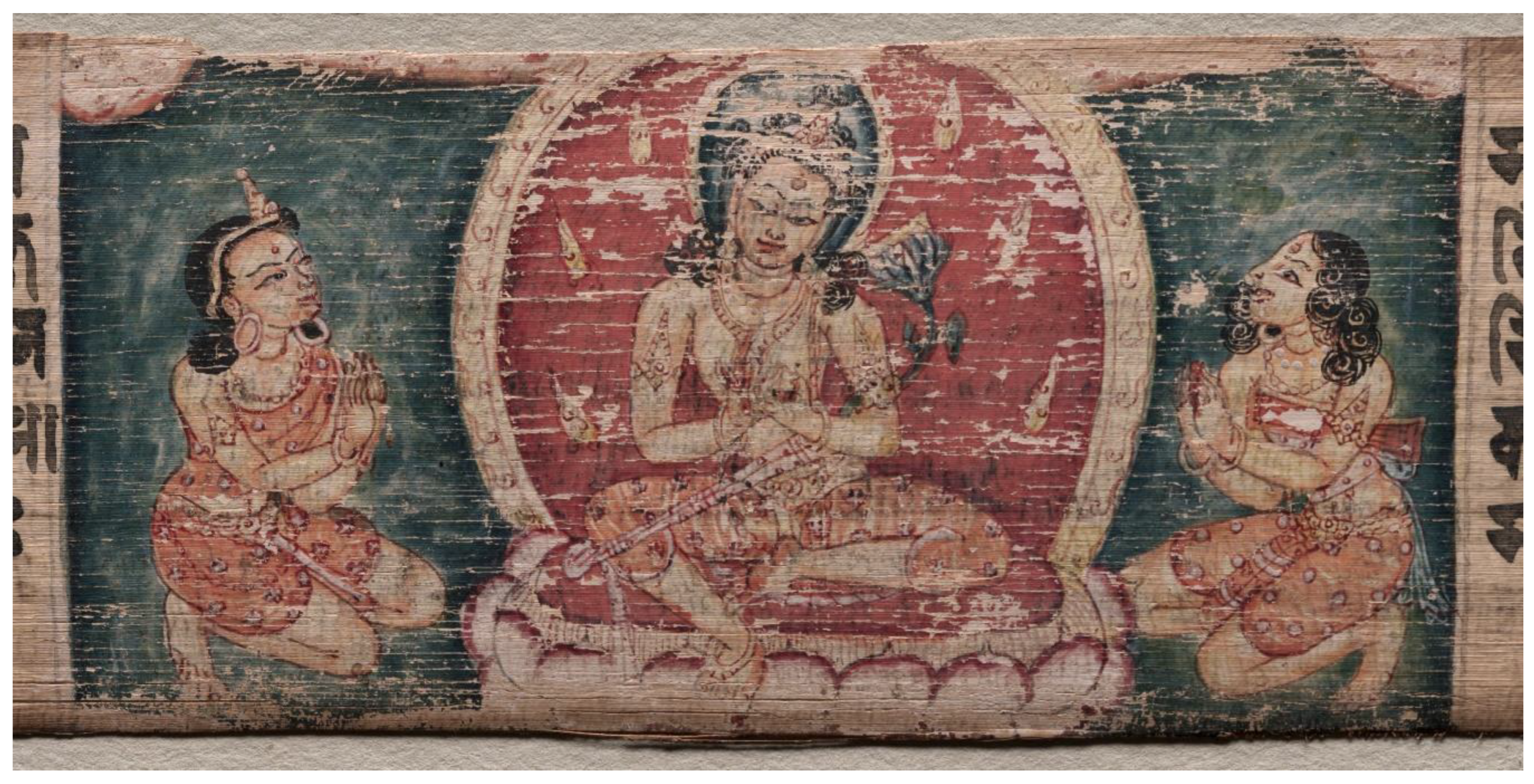
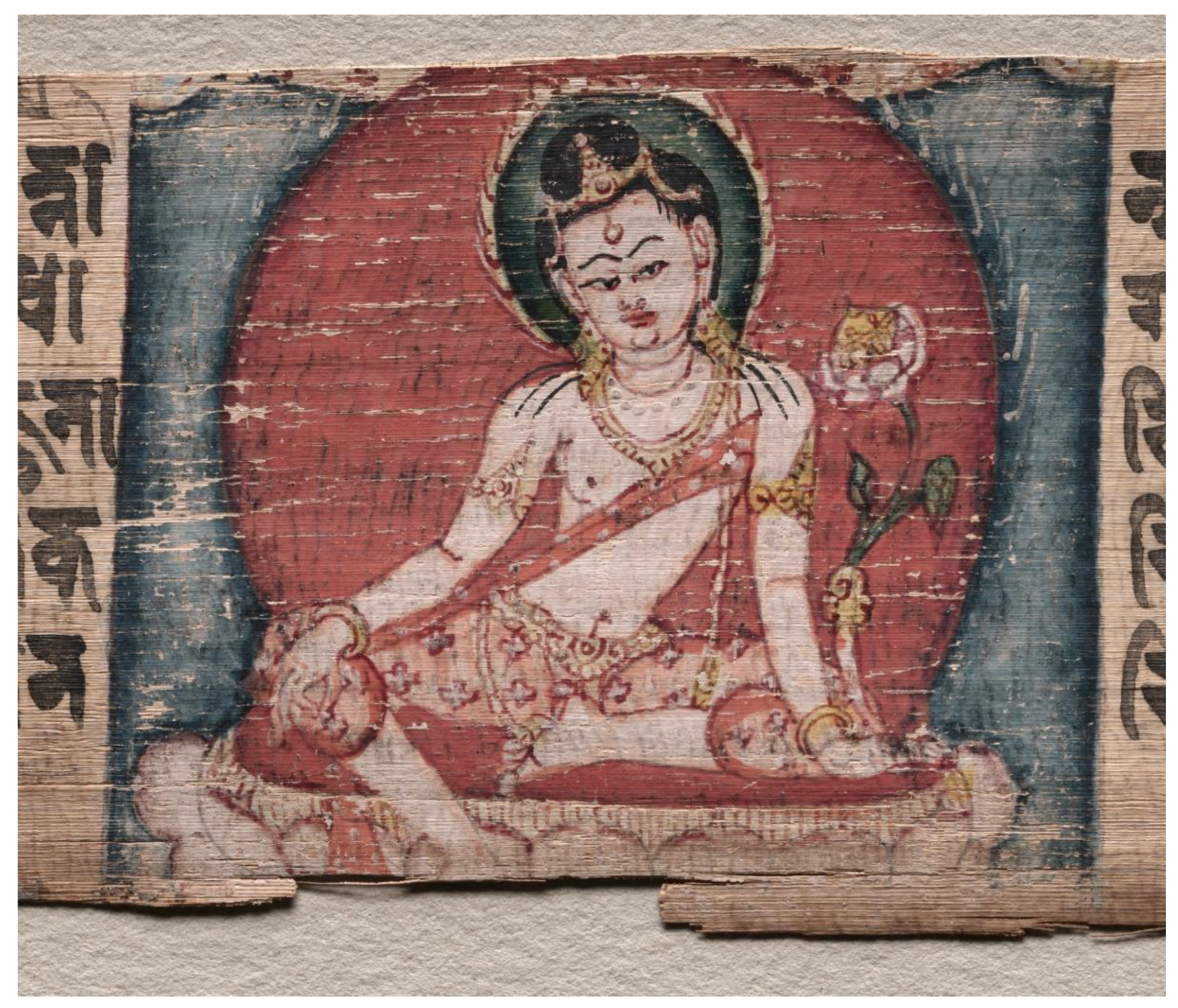
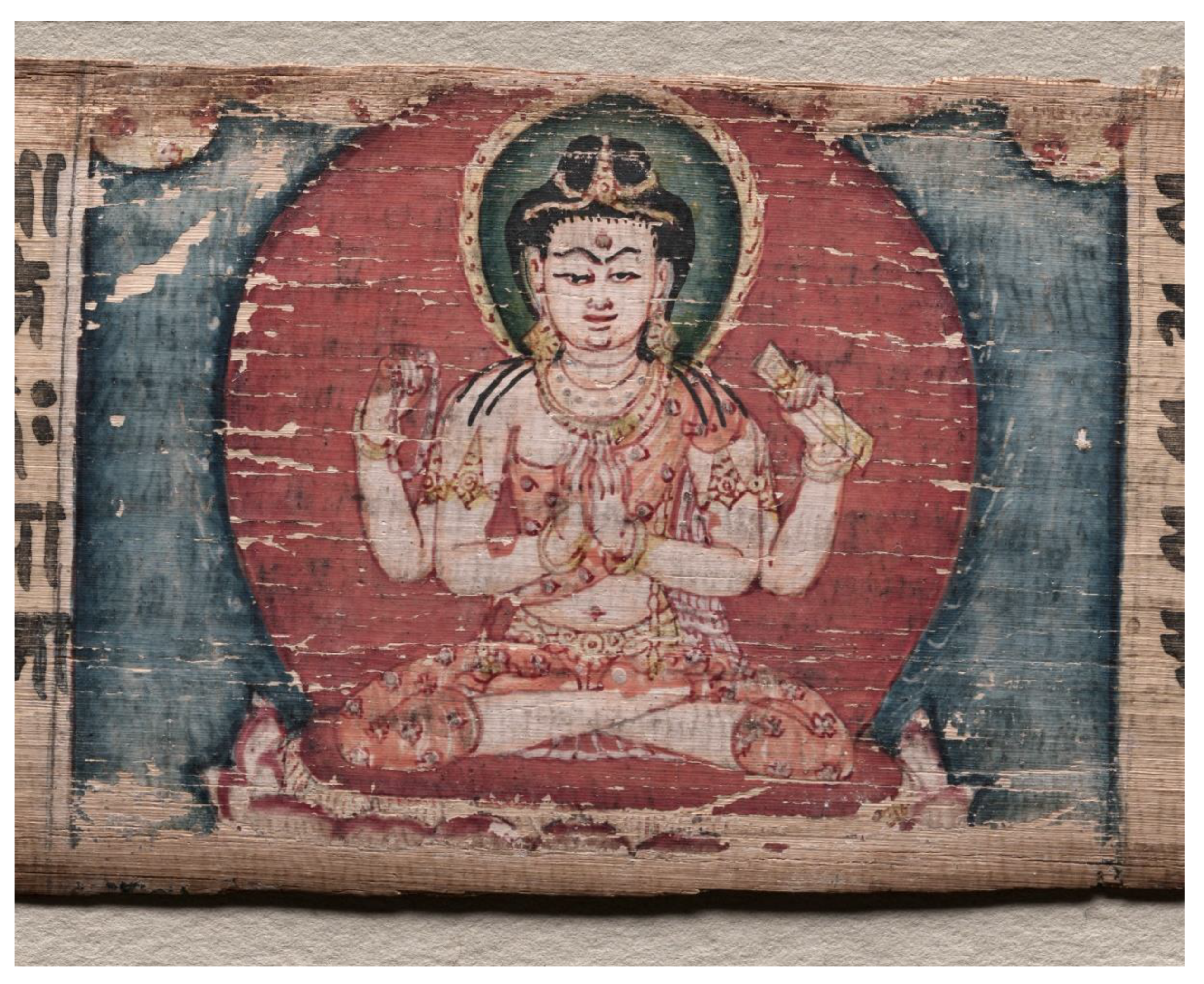

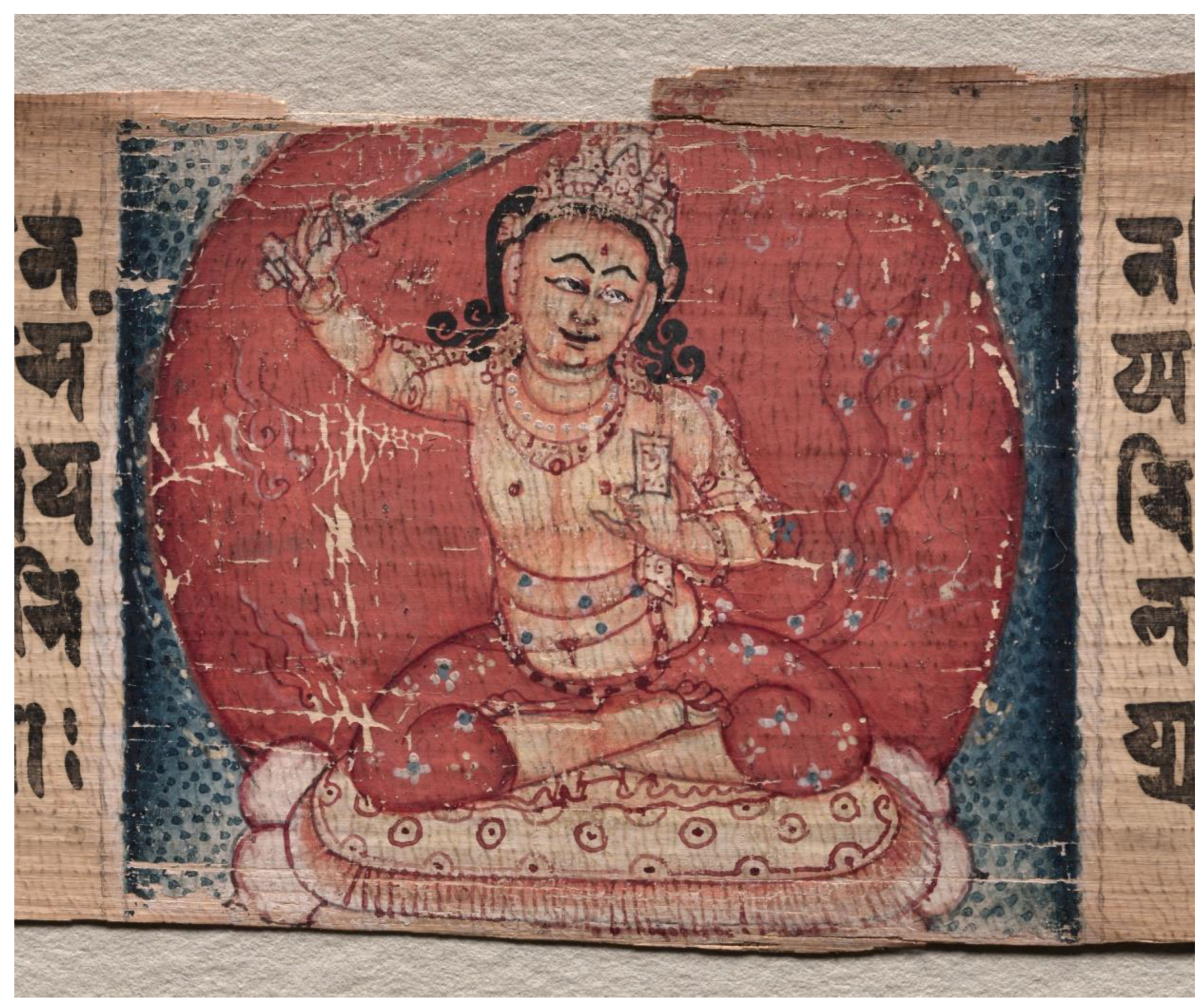

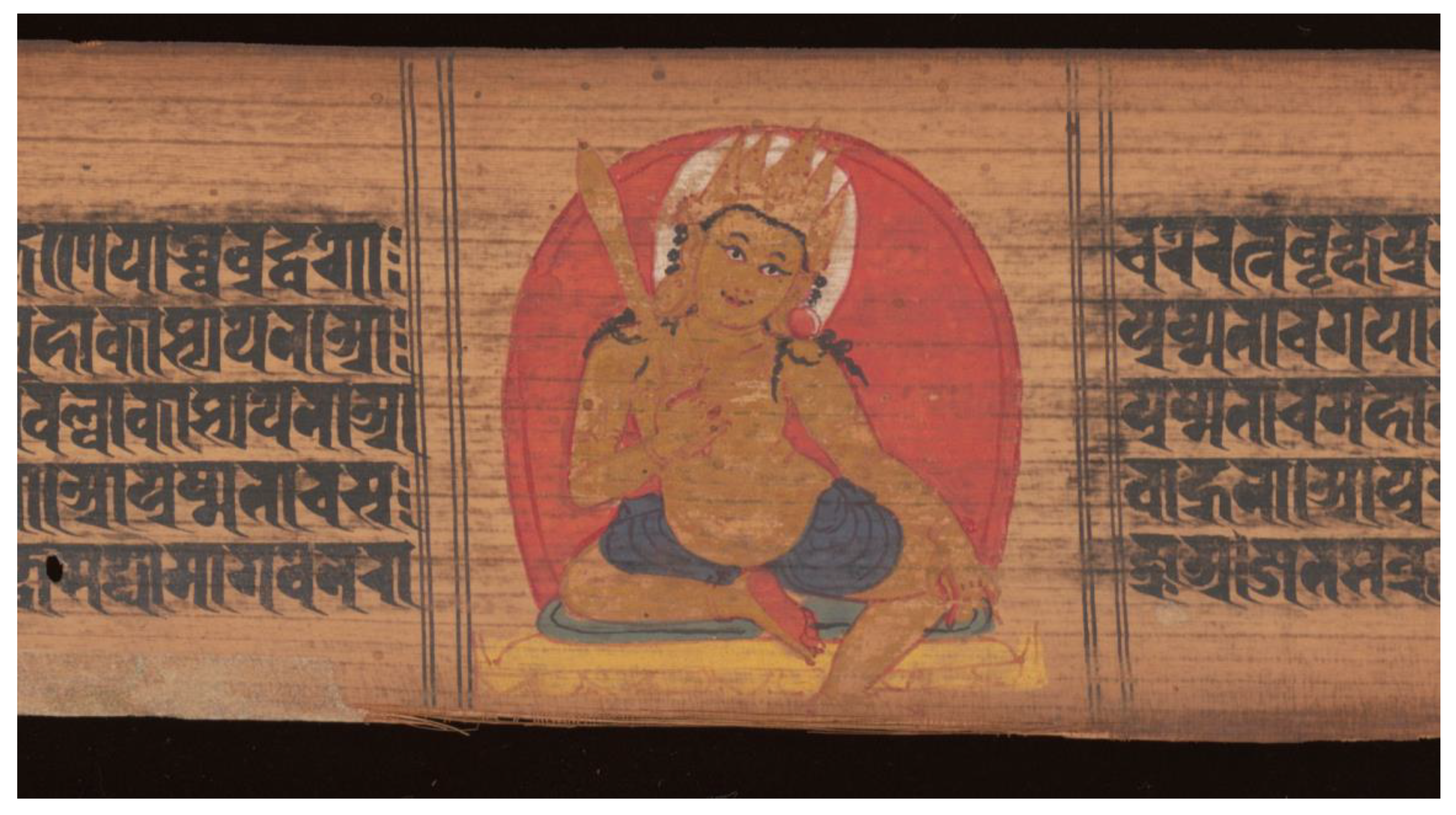
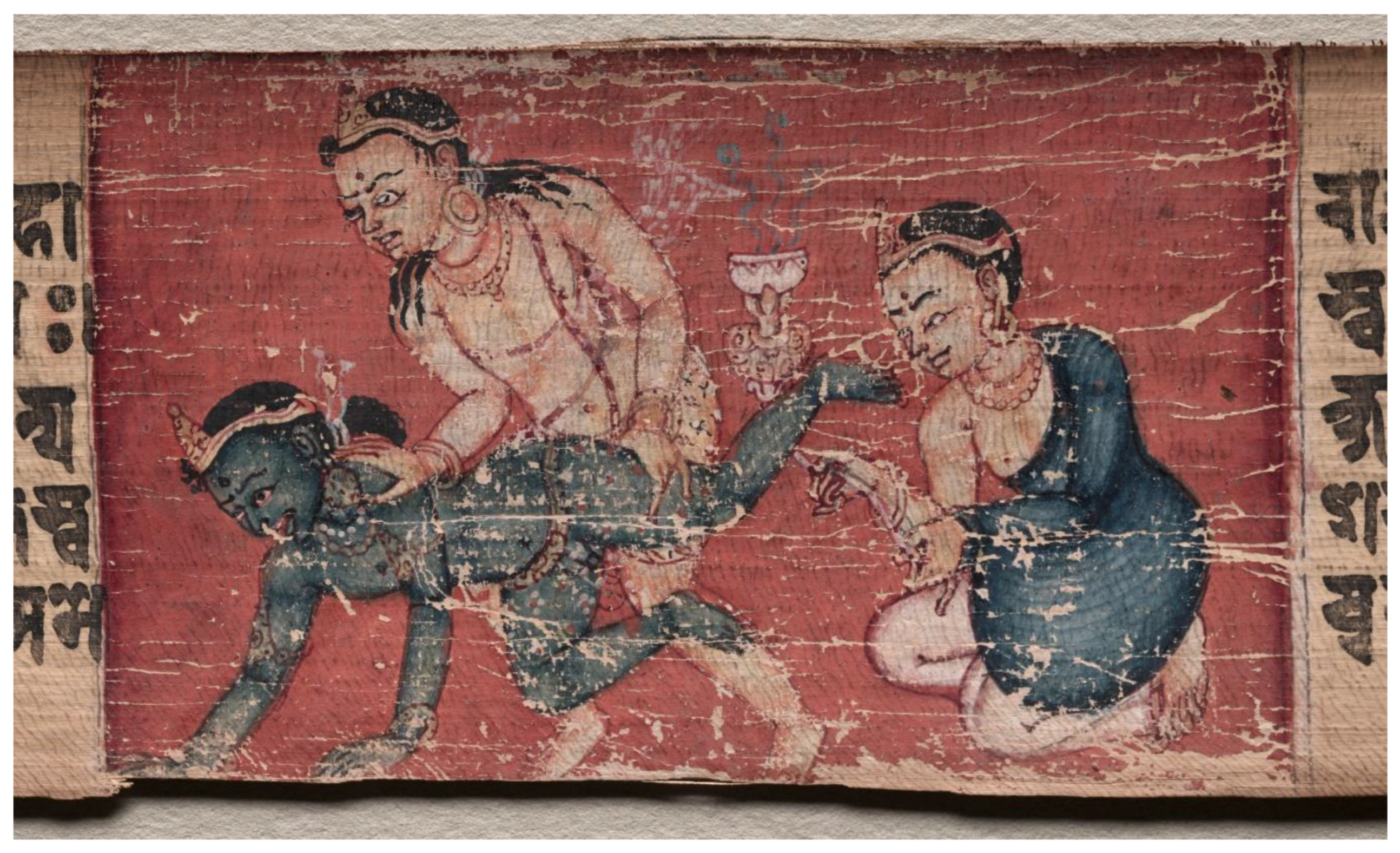
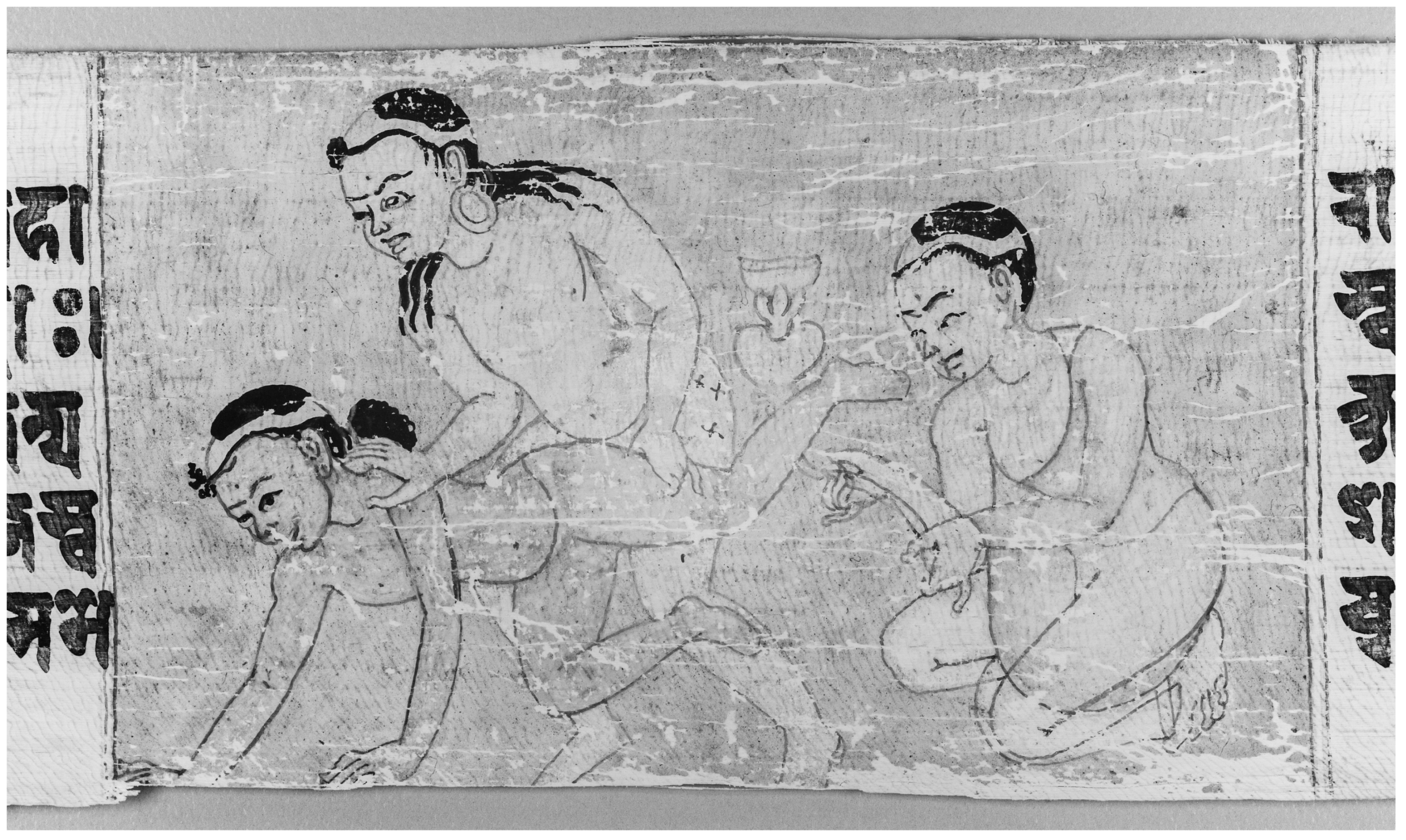

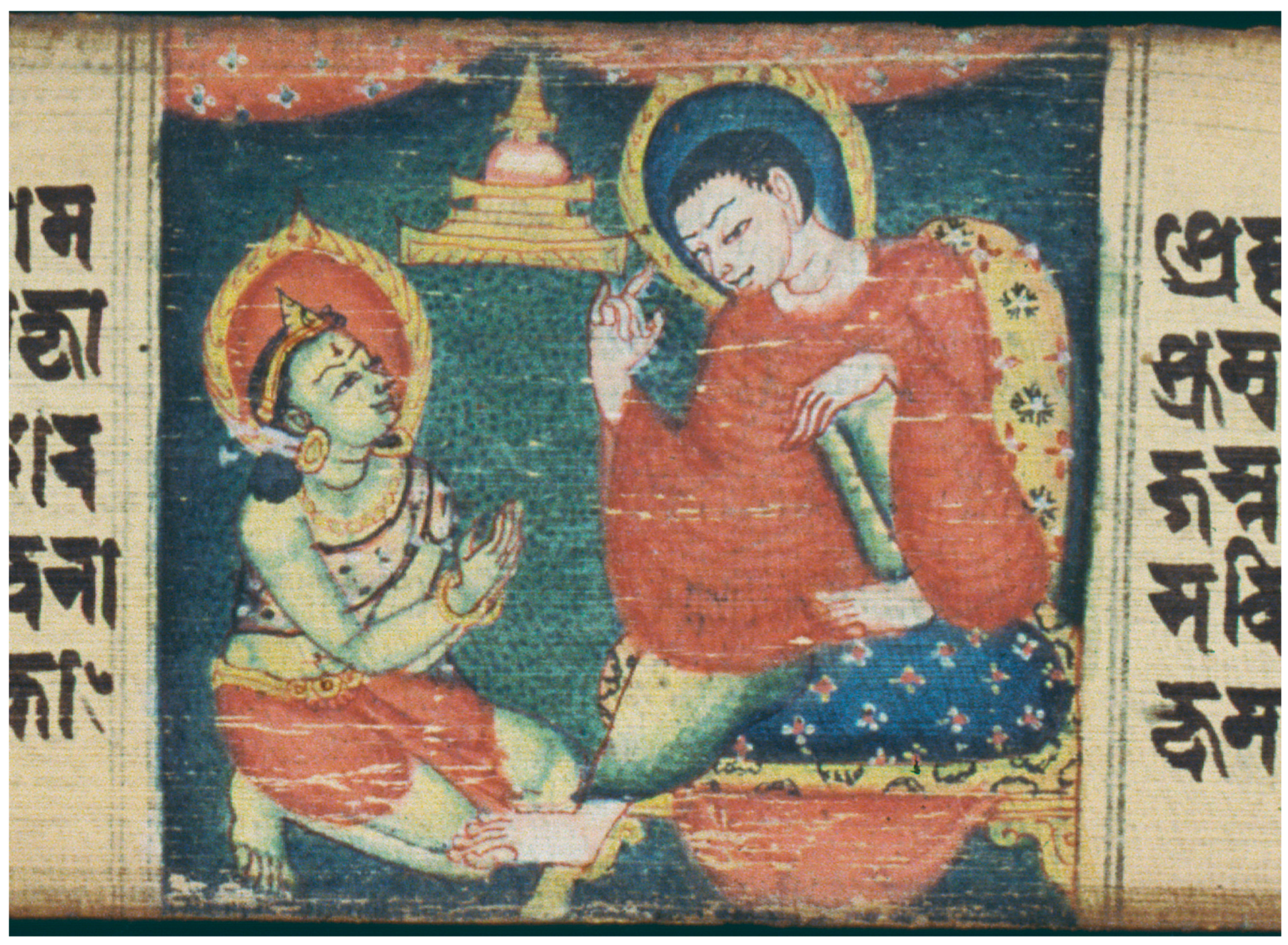
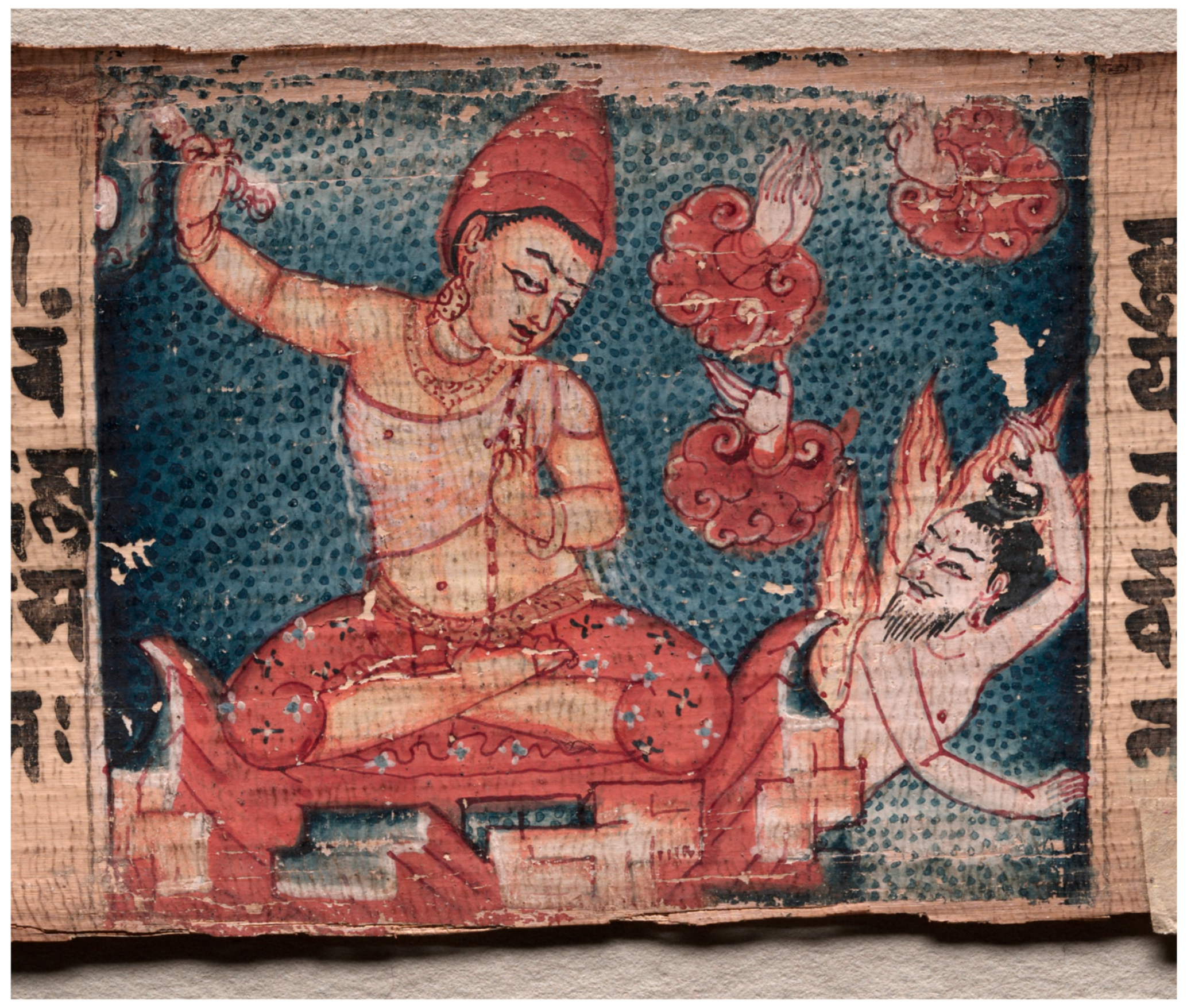

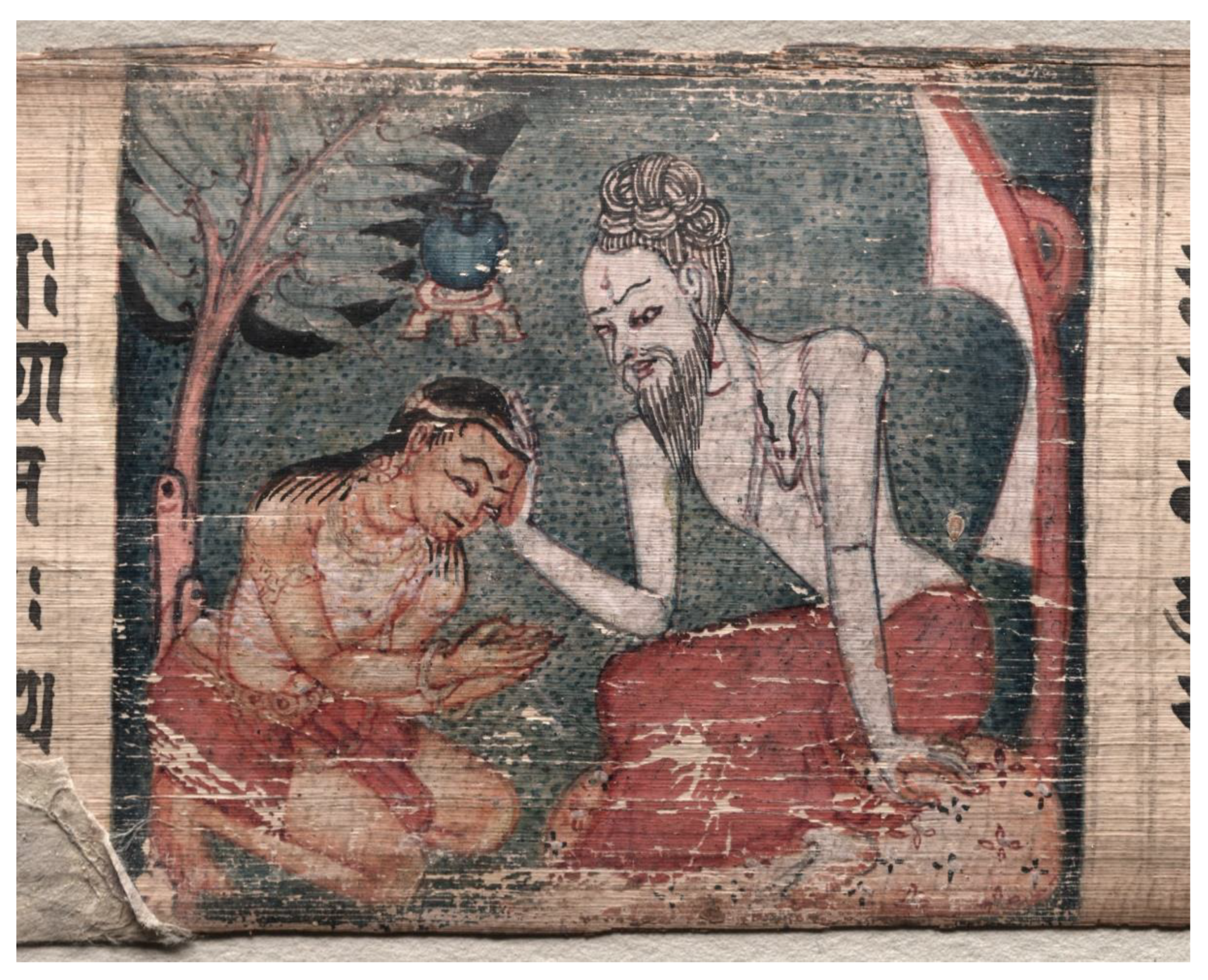
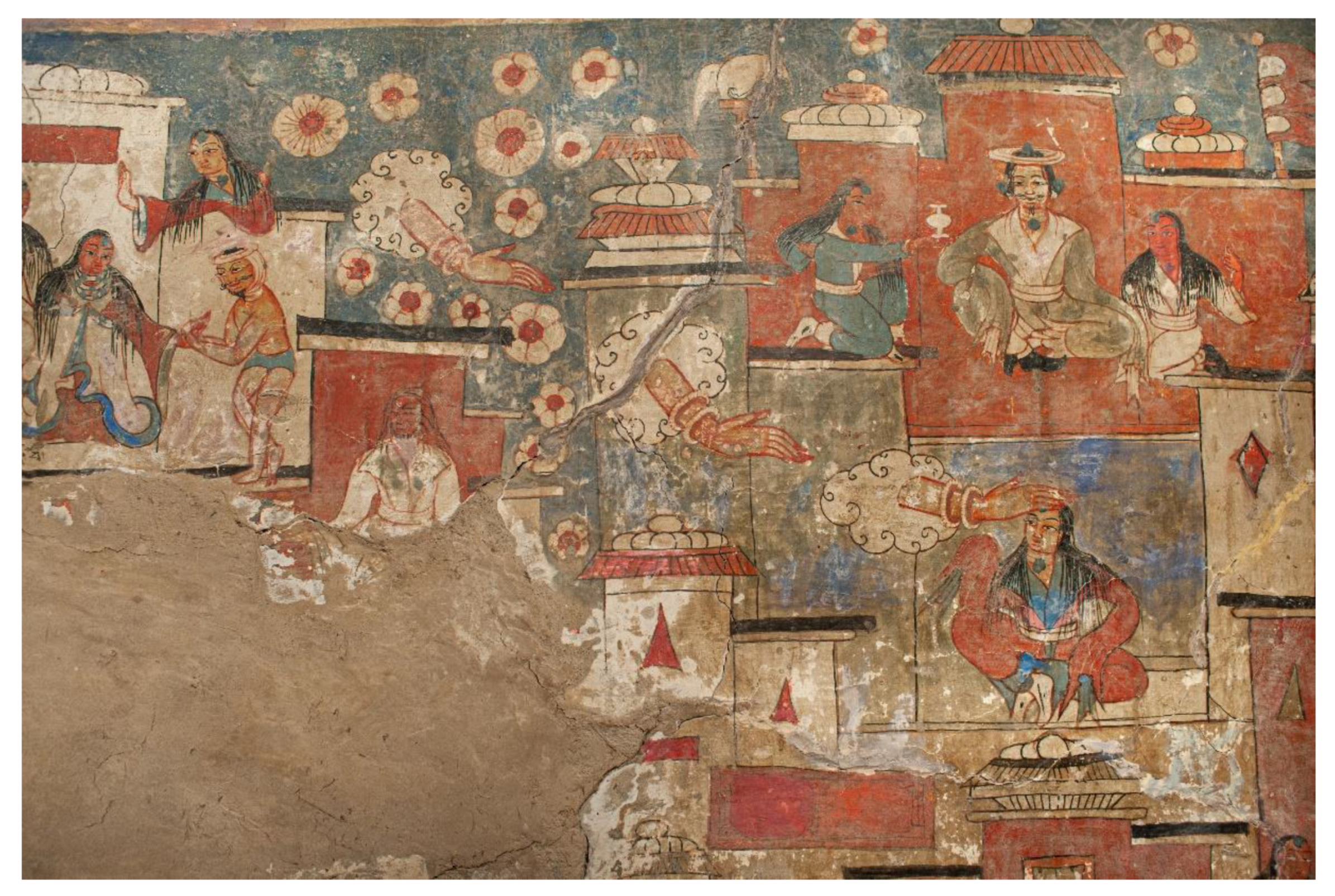
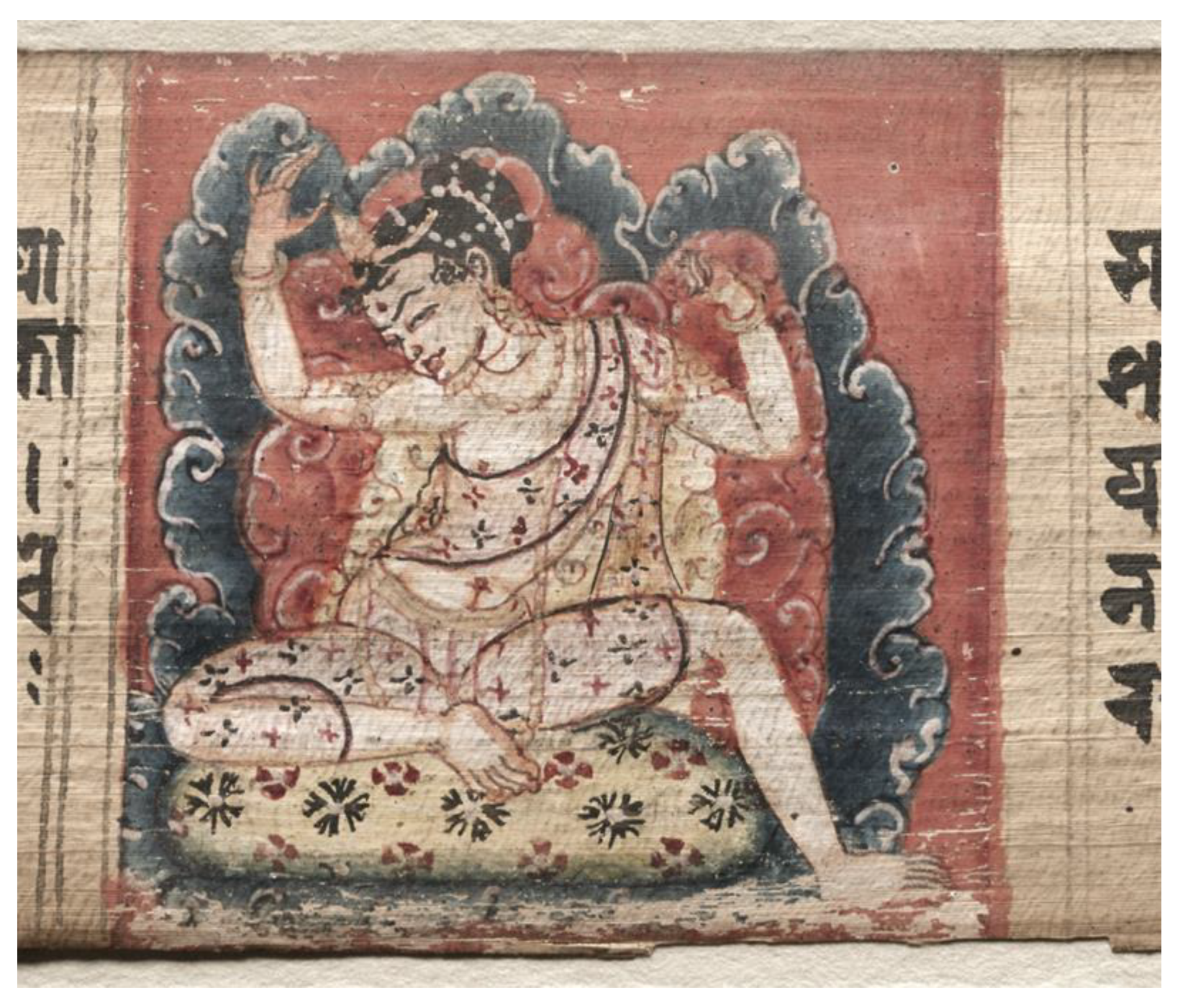
© 2020 by the author. Licensee MDPI, Basel, Switzerland. This article is an open access article distributed under the terms and conditions of the Creative Commons Attribution (CC BY) license (http://creativecommons.org/licenses/by/4.0/).
Share and Cite
Mace, S.R. Clearing the Course: Folio 348 of the Nepalese Gaṇḍavyūha-sūtra in the Cleveland Museum of Art. Religions 2020, 11, 183. https://doi.org/10.3390/rel11040183
Mace SR. Clearing the Course: Folio 348 of the Nepalese Gaṇḍavyūha-sūtra in the Cleveland Museum of Art. Religions. 2020; 11(4):183. https://doi.org/10.3390/rel11040183
Chicago/Turabian StyleMace, Sonya Rhie. 2020. "Clearing the Course: Folio 348 of the Nepalese Gaṇḍavyūha-sūtra in the Cleveland Museum of Art" Religions 11, no. 4: 183. https://doi.org/10.3390/rel11040183
APA StyleMace, S. R. (2020). Clearing the Course: Folio 348 of the Nepalese Gaṇḍavyūha-sūtra in the Cleveland Museum of Art. Religions, 11(4), 183. https://doi.org/10.3390/rel11040183



